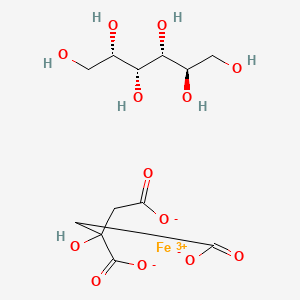
Isoniazid
Übersicht
Beschreibung
Isoniazid, also known as isonicotinic acid hydrazide, is a synthetic antimicrobial agent primarily used in the treatment and prevention of tuberculosis. It was first synthesized in 1912 and introduced into clinical practice in the 1950s. This compound is a first-line antituberculosis medication due to its high efficacy and selectivity against Mycobacterium tuberculosis, the bacterium responsible for tuberculosis .
Wirkmechanismus
Target of Action
Isoniazid is an antibiotic that is primarily used to treat mycobacterial infections . Its primary target is the genus Mycobacterium , specifically M. tuberculosis, M. bovis, and M. kansasii . It is a highly specific agent, ineffective against other microorganisms .
Mode of Action
This compound is a prodrug and must be activated by bacterial catalase . Specifically, activation is associated with the reduction of the mycobacterial ferric KatG catalase-peroxidase by hydrazine and reaction with oxygen to form an oxyferrous enzyme complex . This interaction with its targets results in the inhibition of mycolic acid synthesis, which interferes with cell wall synthesis .
Biochemical Pathways
The antimicrobial activity of this compound is selective for mycobacteria, likely due to its ability to inhibit mycolic acid synthesis , which interferes with cell wall synthesis . This inhibition disrupts the formation of the mycobacterial cell wall . This compound also disrupts DNA, lipid, carbohydrate, and nicotinamide adenine dinucleotide (NAD) synthesis and/or metabolism .
Pharmacokinetics
This compound’s pharmacokinetics are characterized by its absorption rate constant (Ka), oral clearance (CL/F), and apparent volume of distribution (V2/F). The estimated Ka, CL/F, and V2/F for this compound are 3.94 ± 0.44 h−1, 18.2 ± 2.45 L⋅h−1, and 56.8 ± 5.53 L, respectively . The fraction of AcINH formation (FM) was 0.81 ± 0.076 . NAT2 genotypes have different effects on the CL/F and FM .
Result of Action
The result of this compound’s action is bactericidal when mycobacteria grow rapidly and bacteriostatic when they grow slowly . It is active against intracellular and extracellular Mycobacterium tuberculosis . The minimum inhibitory concentration (MIC) of M. tuberculosis for this compound-susceptible isolates generally ranges from 0.03 to 0.125 mcg/mL .
Action Environment
The action environment of this compound is primarily within the human body, where it is used to treat all forms of tuberculosis in which organisms are susceptible . It is also used in combination with rifampin and pyrazinamide . The efficacy and stability of this compound can be influenced by various factors, including the patient’s health status, the presence of other medications, and the patient’s genetic makeup .
Wissenschaftliche Forschungsanwendungen
Isoniazid hat eine breite Palette von Anwendungen in der wissenschaftlichen Forschung:
Chemie: Wird als Reagenz in der organischen Synthese und als Vorläufer für die Synthese verschiedener Derivate verwendet.
Biologie: Wird untersucht wegen seiner Auswirkungen auf die Synthese der bakteriellen Zellwand und seiner Rolle bei bakteriellen Resistenzmechanismen.
Medizin: Wird hauptsächlich zur Behandlung und Vorbeugung von Tuberkulose eingesetzt. .
Industrie: Wird bei der Herstellung von Arzneimitteln und als Zwischenprodukt bei der Synthese anderer chemischer Verbindungen verwendet
5. Wirkmechanismus
This compound ist ein Prodrug, das durch das bakterielle Enzym Katalase-Peroxidase (KatG) aktiviert werden muss. Nach der Aktivierung hemmt es die Synthese von Mycolsäuren, essentiellen Bestandteilen der Mykobakterienzellwand. Diese Hemmung stört die Zellwandsynthese und führt zum Tod der Bakterienzellen. This compound interferiert auch mit der DNA-, Lipid-, Kohlenhydrat- und Nikotinsäureamid-Adenin-Dinukleotid (NAD)-Synthese, was zu seinen bakteriziden Wirkungen beiträgt .
Ähnliche Verbindungen:
Rifampicin: Ein weiteres Anti-Tuberkulose-Medikament der ersten Wahl, das die bakterielle RNA-Synthese hemmt.
Ethambutol: Hemmt die Synthese der Mykobakterienzellwand durch die gezielte Ansprache von Arabinosyltransferasen.
Pyrazinamid: Stört den Mykobakterienzellmembranstoffwechsel und die Transportfunktionen
Einzigartigkeit von this compound: Die Einzigartigkeit von this compound liegt in seinem spezifischen Wirkmechanismus, der auf die Mycolsäure-Synthese abzielt, die für die Mykobakterienzellwand von entscheidender Bedeutung ist. Seine Fähigkeit, sowohl als Monotherapie bei latenter Tuberkulose als auch in Kombination mit anderen Medikamenten bei aktiver Tuberkulose eingesetzt zu werden, macht es zu einem vielseitigen und wichtigen Medikament in der Tuberkulosebehandlung .
Biochemische Analyse
Biochemical Properties
Isoniazid plays a crucial role in biochemical reactions, particularly in the inhibition of mycolic acid synthesis, which is essential for the bacterial cell wall. This compound is a prodrug that requires activation by the bacterial enzyme catalase-peroxidase (KatG). Upon activation, this compound forms an adduct with nicotinamide adenine dinucleotide (NAD), which subsequently inhibits the enzyme InhA, an enoyl-acyl carrier protein reductase involved in mycolic acid synthesis . This inhibition disrupts the synthesis of mycolic acids, leading to the death of the mycobacteria.
Cellular Effects
This compound exerts significant effects on various types of cells and cellular processes. In Mycobacterium tuberculosis, this compound inhibits cell wall synthesis, leading to cell lysis and death. In human cells, this compound can cause hepatotoxicity, which is believed to be mediated by the formation of reactive metabolites through the cytochrome P450 enzyme system . These metabolites can induce oxidative stress and damage cellular components, including lipids, proteins, and DNA. Additionally, this compound has been associated with pyridoxine (vitamin B6) deficiency, as it increases the excretion of pyridoxine, affecting cellular metabolism .
Molecular Mechanism
The molecular mechanism of this compound involves its activation by the bacterial enzyme KatG. The activated form of this compound interacts with NAD to form an adduct that inhibits the enzyme InhA . This inhibition prevents the synthesis of mycolic acids, which are vital components of the mycobacterial cell wall. The disruption of mycolic acid synthesis leads to the loss of cell wall integrity and ultimately the death of the bacterium. Additionally, this compound can induce the expression of genes involved in oxidative stress response, further contributing to its bactericidal effects .
Temporal Effects in Laboratory Settings
In laboratory settings, the effects of this compound can change over time. This compound is known to be relatively stable under standard storage conditions, but it can degrade when exposed to light and moisture . Over time, the degradation products of this compound can reduce its efficacy. Long-term exposure to this compound has been associated with hepatotoxicity in both in vitro and in vivo studies . The hepatotoxic effects are believed to be due to the accumulation of reactive metabolites that induce oxidative stress and liver damage.
Dosage Effects in Animal Models
The effects of this compound vary with different dosages in animal models. At therapeutic doses, this compound effectively inhibits the growth of Mycobacterium tuberculosis. At higher doses, this compound can cause toxic effects, including hepatotoxicity and neurotoxicity . In animal studies, high doses of this compound have been shown to induce liver damage, characterized by elevated liver enzymes and histopathological changes . Additionally, chronic administration of high doses of this compound can lead to peripheral neuropathy, which is attributed to pyridoxine deficiency .
Metabolic Pathways
This compound undergoes extensive metabolism in the liver. The primary metabolic pathway involves acetylation by N-acetyltransferase 2 (NAT2) to form N-acetylthis compound . N-acetylthis compound is further hydrolyzed to isonicotinic acid and monoacetylhydrazine. Monoacetylhydrazine can be oxidized by cytochrome P450 enzymes to form reactive metabolites that contribute to hepatotoxicity . The rate of acetylation varies among individuals, leading to differences in drug clearance and susceptibility to adverse effects .
Transport and Distribution
This compound is well-absorbed from the gastrointestinal tract and is widely distributed throughout the body, including the central nervous system . It has low protein binding and can penetrate tissues and cells effectively. This compound is transported into cells via passive diffusion and is distributed to various tissues, including the liver, lungs, and kidneys . The distribution of this compound is influenced by its lipophilicity and the presence of transporters that facilitate its uptake into cells .
Subcellular Localization
Within cells, this compound is primarily localized in the cytoplasm, where it undergoes metabolic activation and exerts its effects . The activated form of this compound can interact with various cellular components, including enzymes and proteins involved in oxidative stress response . Additionally, this compound can induce the expression of genes involved in the detoxification of reactive metabolites, further influencing its subcellular localization and activity .
Vorbereitungsmethoden
Synthetische Wege und Reaktionsbedingungen: Isoniazid wird typischerweise durch die Reaktion von Isonikotinsäure mit Hydrazinhydrat synthetisiert. Der Prozess beinhaltet die Veresterung von Isonikotinsäure mit einem Alkohol und einem Acylierungsreagenz, um Isonikotinsäureester zu bilden. Dieser Ester wird dann mit Hydrazinhydrat umgesetzt, um this compound zu erzeugen .
Industrielle Produktionsmethoden: In industriellen Umgebungen beinhaltet die Herstellung von this compound die folgenden Schritte:
Veresterung: Isonikotinsäure wird in Gegenwart eines sauren Katalysators mit einem Alkohol (z. B. Methanol) verestert.
Hydrazinolyse: Der Ester wird dann unter kontrollierten Temperaturbedingungen mit Hydrazinhydrat umgesetzt, um this compound zu ergeben.
Reinigung: Das Rohprodukt wird durch Umkristallisation, Entfärbung und Waschen gereinigt, um eine hohe Reinheit und Ausbeute zu erzielen
Analyse Chemischer Reaktionen
Arten von Reaktionen: Isoniazid unterliegt verschiedenen chemischen Reaktionen, darunter:
Oxidation: this compound kann oxidiert werden, um Isonikotinsäure zu bilden.
Reduktion: Es kann reduziert werden, um Hydrazinderivate zu bilden.
Substitution: this compound kann an nukleophilen Substitutionsreaktionen teilnehmen
Häufige Reagenzien und Bedingungen:
Oxidation: Kaliumpermanganat oder Wasserstoffperoxid können als Oxidationsmittel verwendet werden.
Reduktion: Natriumborhydrid oder Lithiumaluminiumhydrid können als Reduktionsmittel verwendet werden.
Substitution: Alkylhalogenide oder Acylchloride können für nukleophile Substitutionsreaktionen verwendet werden
Hauptprodukte:
Oxidation: Isonikotinsäure.
Reduktion: Hydrazinderivate.
Substitution: Verschiedene substituierte Isonikotinsäurederivate
Vergleich Mit ähnlichen Verbindungen
Rifampicin: Another first-line antituberculosis drug that inhibits bacterial RNA synthesis.
Ethambutol: Inhibits the synthesis of the mycobacterial cell wall by targeting arabinosyl transferases.
Pyrazinamide: Disrupts mycobacterial cell membrane metabolism and transport functions
Uniqueness of Isoniazid: this compound’s uniqueness lies in its specific mechanism of action, targeting mycolic acid synthesis, which is crucial for the mycobacterial cell wall. Its ability to be used both as a monotherapy for latent tuberculosis and in combination with other drugs for active tuberculosis makes it a versatile and essential medication in tuberculosis treatment .
Eigenschaften
IUPAC Name |
pyridine-4-carbohydrazide | |
|---|---|---|
| Source | PubChem | |
| URL | https://pubchem.ncbi.nlm.nih.gov | |
| Description | Data deposited in or computed by PubChem | |
InChI |
InChI=1S/C6H7N3O/c7-9-6(10)5-1-3-8-4-2-5/h1-4H,7H2,(H,9,10) | |
| Source | PubChem | |
| URL | https://pubchem.ncbi.nlm.nih.gov | |
| Description | Data deposited in or computed by PubChem | |
InChI Key |
QRXWMOHMRWLFEY-UHFFFAOYSA-N | |
| Source | PubChem | |
| URL | https://pubchem.ncbi.nlm.nih.gov | |
| Description | Data deposited in or computed by PubChem | |
Canonical SMILES |
C1=CN=CC=C1C(=O)NN | |
| Source | PubChem | |
| URL | https://pubchem.ncbi.nlm.nih.gov | |
| Description | Data deposited in or computed by PubChem | |
Molecular Formula |
C6H7N3O | |
| Record name | ISONIAZID | |
| Source | CAMEO Chemicals | |
| URL | https://cameochemicals.noaa.gov/chemical/20540 | |
| Description | CAMEO Chemicals is a chemical database designed for people who are involved in hazardous material incident response and planning. CAMEO Chemicals contains a library with thousands of datasheets containing response-related information and recommendations for hazardous materials that are commonly transported, used, or stored in the United States. CAMEO Chemicals was developed by the National Oceanic and Atmospheric Administration's Office of Response and Restoration in partnership with the Environmental Protection Agency's Office of Emergency Management. | |
| Explanation | CAMEO Chemicals and all other CAMEO products are available at no charge to those organizations and individuals (recipients) responsible for the safe handling of chemicals. However, some of the chemical data itself is subject to the copyright restrictions of the companies or organizations that provided the data. | |
| Record name | ISONIAZID (OBSOLETE) | |
| Source | ILO-WHO International Chemical Safety Cards (ICSCs) | |
| URL | https://www.ilo.org/dyn/icsc/showcard.display?p_version=2&p_card_id=1258 | |
| Description | The International Chemical Safety Cards (ICSCs) are data sheets intended to provide essential safety and health information on chemicals in a clear and concise way. The primary aim of the Cards is to promote the safe use of chemicals in the workplace. | |
| Explanation | Creative Commons CC BY 4.0 | |
| Record name | isoniazid | |
| Source | Wikipedia | |
| URL | https://en.wikipedia.org/wiki/Isoniazid | |
| Description | Chemical information link to Wikipedia. | |
| Source | PubChem | |
| URL | https://pubchem.ncbi.nlm.nih.gov | |
| Description | Data deposited in or computed by PubChem | |
DSSTOX Substance ID |
DTXSID8020755 | |
| Record name | Isoniazid | |
| Source | EPA DSSTox | |
| URL | https://comptox.epa.gov/dashboard/DTXSID8020755 | |
| Description | DSSTox provides a high quality public chemistry resource for supporting improved predictive toxicology. | |
Molecular Weight |
137.14 g/mol | |
| Source | PubChem | |
| URL | https://pubchem.ncbi.nlm.nih.gov | |
| Description | Data deposited in or computed by PubChem | |
Physical Description |
Isoniazid appears as odorless colorless or white crystals or white crystalline powder. Taste is slightly sweet at first and then bitter. pH (1% aqueous solution) 5.5-6.5. pH (5% aqueous solution) 6-8. (NTP, 1992), Solid, WHITE CRYSTALLINE ODOURLESS POWDER. | |
| Record name | ISONIAZID | |
| Source | CAMEO Chemicals | |
| URL | https://cameochemicals.noaa.gov/chemical/20540 | |
| Description | CAMEO Chemicals is a chemical database designed for people who are involved in hazardous material incident response and planning. CAMEO Chemicals contains a library with thousands of datasheets containing response-related information and recommendations for hazardous materials that are commonly transported, used, or stored in the United States. CAMEO Chemicals was developed by the National Oceanic and Atmospheric Administration's Office of Response and Restoration in partnership with the Environmental Protection Agency's Office of Emergency Management. | |
| Explanation | CAMEO Chemicals and all other CAMEO products are available at no charge to those organizations and individuals (recipients) responsible for the safe handling of chemicals. However, some of the chemical data itself is subject to the copyright restrictions of the companies or organizations that provided the data. | |
| Record name | Isoniazid | |
| Source | Human Metabolome Database (HMDB) | |
| URL | http://www.hmdb.ca/metabolites/HMDB0015086 | |
| Description | The Human Metabolome Database (HMDB) is a freely available electronic database containing detailed information about small molecule metabolites found in the human body. | |
| Explanation | HMDB is offered to the public as a freely available resource. Use and re-distribution of the data, in whole or in part, for commercial purposes requires explicit permission of the authors and explicit acknowledgment of the source material (HMDB) and the original publication (see the HMDB citing page). We ask that users who download significant portions of the database cite the HMDB paper in any resulting publications. | |
| Record name | ISONIAZID (OBSOLETE) | |
| Source | ILO-WHO International Chemical Safety Cards (ICSCs) | |
| URL | https://www.ilo.org/dyn/icsc/showcard.display?p_version=2&p_card_id=1258 | |
| Description | The International Chemical Safety Cards (ICSCs) are data sheets intended to provide essential safety and health information on chemicals in a clear and concise way. The primary aim of the Cards is to promote the safe use of chemicals in the workplace. | |
| Explanation | Creative Commons CC BY 4.0 | |
Flash Point |
374 °F (NTP, 1992), > 250 °C | |
| Record name | ISONIAZID | |
| Source | CAMEO Chemicals | |
| URL | https://cameochemicals.noaa.gov/chemical/20540 | |
| Description | CAMEO Chemicals is a chemical database designed for people who are involved in hazardous material incident response and planning. CAMEO Chemicals contains a library with thousands of datasheets containing response-related information and recommendations for hazardous materials that are commonly transported, used, or stored in the United States. CAMEO Chemicals was developed by the National Oceanic and Atmospheric Administration's Office of Response and Restoration in partnership with the Environmental Protection Agency's Office of Emergency Management. | |
| Explanation | CAMEO Chemicals and all other CAMEO products are available at no charge to those organizations and individuals (recipients) responsible for the safe handling of chemicals. However, some of the chemical data itself is subject to the copyright restrictions of the companies or organizations that provided the data. | |
| Record name | ISONIAZID (OBSOLETE) | |
| Source | ILO-WHO International Chemical Safety Cards (ICSCs) | |
| URL | https://www.ilo.org/dyn/icsc/showcard.display?p_version=2&p_card_id=1258 | |
| Description | The International Chemical Safety Cards (ICSCs) are data sheets intended to provide essential safety and health information on chemicals in a clear and concise way. The primary aim of the Cards is to promote the safe use of chemicals in the workplace. | |
| Explanation | Creative Commons CC BY 4.0 | |
Solubility |
13.7 [ug/mL] (The mean of the results at pH 7.4), greater than or equal to 100 mg/mL at 77 °F (NTP, 1992), Solubility in alcohol at 25 °C: about 2, in boiling alcohol: about 10%; in chloroform: about 0.1%. Practically insoluble in ether, benzene., Sol in methyl ethyl ketone, acetone, In water, 1.4X10+5 mg/L at 25 °C, 3.49e+01 g/L, Solubility in water, g/100ml at 20 °C: 12.5 | |
| Record name | SID855769 | |
| Source | Burnham Center for Chemical Genomics | |
| URL | https://pubchem.ncbi.nlm.nih.gov/bioassay/1996#section=Data-Table | |
| Description | Aqueous solubility in buffer at pH 7.4 | |
| Record name | ISONIAZID | |
| Source | CAMEO Chemicals | |
| URL | https://cameochemicals.noaa.gov/chemical/20540 | |
| Description | CAMEO Chemicals is a chemical database designed for people who are involved in hazardous material incident response and planning. CAMEO Chemicals contains a library with thousands of datasheets containing response-related information and recommendations for hazardous materials that are commonly transported, used, or stored in the United States. CAMEO Chemicals was developed by the National Oceanic and Atmospheric Administration's Office of Response and Restoration in partnership with the Environmental Protection Agency's Office of Emergency Management. | |
| Explanation | CAMEO Chemicals and all other CAMEO products are available at no charge to those organizations and individuals (recipients) responsible for the safe handling of chemicals. However, some of the chemical data itself is subject to the copyright restrictions of the companies or organizations that provided the data. | |
| Record name | Isoniazid | |
| Source | DrugBank | |
| URL | https://www.drugbank.ca/drugs/DB00951 | |
| Description | The DrugBank database is a unique bioinformatics and cheminformatics resource that combines detailed drug (i.e. chemical, pharmacological and pharmaceutical) data with comprehensive drug target (i.e. sequence, structure, and pathway) information. | |
| Explanation | Creative Common's Attribution-NonCommercial 4.0 International License (http://creativecommons.org/licenses/by-nc/4.0/legalcode) | |
| Record name | ISONIAZID | |
| Source | Hazardous Substances Data Bank (HSDB) | |
| URL | https://pubchem.ncbi.nlm.nih.gov/source/hsdb/1647 | |
| Description | The Hazardous Substances Data Bank (HSDB) is a toxicology database that focuses on the toxicology of potentially hazardous chemicals. It provides information on human exposure, industrial hygiene, emergency handling procedures, environmental fate, regulatory requirements, nanomaterials, and related areas. The information in HSDB has been assessed by a Scientific Review Panel. | |
| Record name | Isoniazid | |
| Source | Human Metabolome Database (HMDB) | |
| URL | http://www.hmdb.ca/metabolites/HMDB0015086 | |
| Description | The Human Metabolome Database (HMDB) is a freely available electronic database containing detailed information about small molecule metabolites found in the human body. | |
| Explanation | HMDB is offered to the public as a freely available resource. Use and re-distribution of the data, in whole or in part, for commercial purposes requires explicit permission of the authors and explicit acknowledgment of the source material (HMDB) and the original publication (see the HMDB citing page). We ask that users who download significant portions of the database cite the HMDB paper in any resulting publications. | |
| Record name | ISONIAZID (OBSOLETE) | |
| Source | ILO-WHO International Chemical Safety Cards (ICSCs) | |
| URL | https://www.ilo.org/dyn/icsc/showcard.display?p_version=2&p_card_id=1258 | |
| Description | The International Chemical Safety Cards (ICSCs) are data sheets intended to provide essential safety and health information on chemicals in a clear and concise way. The primary aim of the Cards is to promote the safe use of chemicals in the workplace. | |
| Explanation | Creative Commons CC BY 4.0 | |
Vapor Pressure |
Negligible (NTP, 1992), 4.6X10-5 mm Hg at 25 °C /Estimated/ | |
| Record name | ISONIAZID | |
| Source | CAMEO Chemicals | |
| URL | https://cameochemicals.noaa.gov/chemical/20540 | |
| Description | CAMEO Chemicals is a chemical database designed for people who are involved in hazardous material incident response and planning. CAMEO Chemicals contains a library with thousands of datasheets containing response-related information and recommendations for hazardous materials that are commonly transported, used, or stored in the United States. CAMEO Chemicals was developed by the National Oceanic and Atmospheric Administration's Office of Response and Restoration in partnership with the Environmental Protection Agency's Office of Emergency Management. | |
| Explanation | CAMEO Chemicals and all other CAMEO products are available at no charge to those organizations and individuals (recipients) responsible for the safe handling of chemicals. However, some of the chemical data itself is subject to the copyright restrictions of the companies or organizations that provided the data. | |
| Record name | ISONIAZID | |
| Source | Hazardous Substances Data Bank (HSDB) | |
| URL | https://pubchem.ncbi.nlm.nih.gov/source/hsdb/1647 | |
| Description | The Hazardous Substances Data Bank (HSDB) is a toxicology database that focuses on the toxicology of potentially hazardous chemicals. It provides information on human exposure, industrial hygiene, emergency handling procedures, environmental fate, regulatory requirements, nanomaterials, and related areas. The information in HSDB has been assessed by a Scientific Review Panel. | |
Mechanism of Action |
Isoniazid is a prodrug and must be activated by bacterial catalase. Specficially, activation is associated with reduction of the mycobacterial ferric KatG catalase-peroxidase by hydrazine and reaction with oxygen to form an oxyferrous enzyme complex. Once activated, isoniazid inhibits the synthesis of mycoloic acids, an essential component of the bacterial cell wall. At therapeutic levels isoniazid is bacteriocidal against actively growing intracellular and extracellular Mycobacterium tuberculosis organisms. Specifically isoniazid inhibits InhA, the enoyl reductase from Mycobacterium tuberculosis, by forming a covalent adduct with the NAD cofactor. It is the INH-NAD adduct that acts as a slow, tight-binding competitive inhibitor of InhA., Although the mechanism of action of isoniazid is unknown, several hypotheses have been proposed. These include effects on lipids, nucleic acid biosynthesis, and glycolysis. ... /It has been suggested that/ a primary action of isoniazid /is/ to inhibit the biosynthesis of mycolic acids, important constituents of the mycobacterial cell wall. Because mycolic acids are unique to mycobacteria, this action would explain the high degree of selectivity of the antimicrobial activity of isoniazid. Exposure to isoniazid leads to a loss of acid fastness and a decrease in the quantity of methanol-extractable lipid of the microorganisms., Isoniazid is bacteriostatic for "resting" bacilli but is bactericidal for rapidly dividing microorganisms. The minimal tuberculostatic concentration is 0.025 to 0.05 ug/ml. | |
| Record name | Isoniazid | |
| Source | DrugBank | |
| URL | https://www.drugbank.ca/drugs/DB00951 | |
| Description | The DrugBank database is a unique bioinformatics and cheminformatics resource that combines detailed drug (i.e. chemical, pharmacological and pharmaceutical) data with comprehensive drug target (i.e. sequence, structure, and pathway) information. | |
| Explanation | Creative Common's Attribution-NonCommercial 4.0 International License (http://creativecommons.org/licenses/by-nc/4.0/legalcode) | |
| Record name | ISONIAZID | |
| Source | Hazardous Substances Data Bank (HSDB) | |
| URL | https://pubchem.ncbi.nlm.nih.gov/source/hsdb/1647 | |
| Description | The Hazardous Substances Data Bank (HSDB) is a toxicology database that focuses on the toxicology of potentially hazardous chemicals. It provides information on human exposure, industrial hygiene, emergency handling procedures, environmental fate, regulatory requirements, nanomaterials, and related areas. The information in HSDB has been assessed by a Scientific Review Panel. | |
Color/Form |
COLORLESS OR WHITE CRYSTALS, OR A WHITE, CRYSTALLINE POWDER, Crystals from alcohol | |
CAS No. |
54-85-3 | |
| Record name | ISONIAZID | |
| Source | CAMEO Chemicals | |
| URL | https://cameochemicals.noaa.gov/chemical/20540 | |
| Description | CAMEO Chemicals is a chemical database designed for people who are involved in hazardous material incident response and planning. CAMEO Chemicals contains a library with thousands of datasheets containing response-related information and recommendations for hazardous materials that are commonly transported, used, or stored in the United States. CAMEO Chemicals was developed by the National Oceanic and Atmospheric Administration's Office of Response and Restoration in partnership with the Environmental Protection Agency's Office of Emergency Management. | |
| Explanation | CAMEO Chemicals and all other CAMEO products are available at no charge to those organizations and individuals (recipients) responsible for the safe handling of chemicals. However, some of the chemical data itself is subject to the copyright restrictions of the companies or organizations that provided the data. | |
| Record name | Isoniazid | |
| Source | CAS Common Chemistry | |
| URL | https://commonchemistry.cas.org/detail?cas_rn=54-85-3 | |
| Description | CAS Common Chemistry is an open community resource for accessing chemical information. Nearly 500,000 chemical substances from CAS REGISTRY cover areas of community interest, including common and frequently regulated chemicals, and those relevant to high school and undergraduate chemistry classes. This chemical information, curated by our expert scientists, is provided in alignment with our mission as a division of the American Chemical Society. | |
| Explanation | The data from CAS Common Chemistry is provided under a CC-BY-NC 4.0 license, unless otherwise stated. | |
| Record name | Isoniazid [USP:INN:BAN:JAN] | |
| Source | ChemIDplus | |
| URL | https://pubchem.ncbi.nlm.nih.gov/substance/?source=chemidplus&sourceid=0000054853 | |
| Description | ChemIDplus is a free, web search system that provides access to the structure and nomenclature authority files used for the identification of chemical substances cited in National Library of Medicine (NLM) databases, including the TOXNET system. | |
| Record name | Isoniazid | |
| Source | DrugBank | |
| URL | https://www.drugbank.ca/drugs/DB00951 | |
| Description | The DrugBank database is a unique bioinformatics and cheminformatics resource that combines detailed drug (i.e. chemical, pharmacological and pharmaceutical) data with comprehensive drug target (i.e. sequence, structure, and pathway) information. | |
| Explanation | Creative Common's Attribution-NonCommercial 4.0 International License (http://creativecommons.org/licenses/by-nc/4.0/legalcode) | |
| Record name | isoniazid | |
| Source | DTP/NCI | |
| URL | https://dtp.cancer.gov/dtpstandard/servlet/dwindex?searchtype=NSC&outputformat=html&searchlist=757078 | |
| Description | The NCI Development Therapeutics Program (DTP) provides services and resources to the academic and private-sector research communities worldwide to facilitate the discovery and development of new cancer therapeutic agents. | |
| Explanation | Unless otherwise indicated, all text within NCI products is free of copyright and may be reused without our permission. Credit the National Cancer Institute as the source. | |
| Record name | isoniazid | |
| Source | DTP/NCI | |
| URL | https://dtp.cancer.gov/dtpstandard/servlet/dwindex?searchtype=NSC&outputformat=html&searchlist=9659 | |
| Description | The NCI Development Therapeutics Program (DTP) provides services and resources to the academic and private-sector research communities worldwide to facilitate the discovery and development of new cancer therapeutic agents. | |
| Explanation | Unless otherwise indicated, all text within NCI products is free of copyright and may be reused without our permission. Credit the National Cancer Institute as the source. | |
| Record name | 4-Pyridinecarboxylic acid, hydrazide | |
| Source | EPA Chemicals under the TSCA | |
| URL | https://www.epa.gov/chemicals-under-tsca | |
| Description | EPA Chemicals under the Toxic Substances Control Act (TSCA) collection contains information on chemicals and their regulations under TSCA, including non-confidential content from the TSCA Chemical Substance Inventory and Chemical Data Reporting. | |
| Record name | Isoniazid | |
| Source | EPA DSSTox | |
| URL | https://comptox.epa.gov/dashboard/DTXSID8020755 | |
| Description | DSSTox provides a high quality public chemistry resource for supporting improved predictive toxicology. | |
| Record name | Isoniazid | |
| Source | European Chemicals Agency (ECHA) | |
| URL | https://echa.europa.eu/substance-information/-/substanceinfo/100.000.195 | |
| Description | The European Chemicals Agency (ECHA) is an agency of the European Union which is the driving force among regulatory authorities in implementing the EU's groundbreaking chemicals legislation for the benefit of human health and the environment as well as for innovation and competitiveness. | |
| Explanation | Use of the information, documents and data from the ECHA website is subject to the terms and conditions of this Legal Notice, and subject to other binding limitations provided for under applicable law, the information, documents and data made available on the ECHA website may be reproduced, distributed and/or used, totally or in part, for non-commercial purposes provided that ECHA is acknowledged as the source: "Source: European Chemicals Agency, http://echa.europa.eu/". Such acknowledgement must be included in each copy of the material. ECHA permits and encourages organisations and individuals to create links to the ECHA website under the following cumulative conditions: Links can only be made to webpages that provide a link to the Legal Notice page. | |
| Record name | ISONIAZID | |
| Source | FDA Global Substance Registration System (GSRS) | |
| URL | https://gsrs.ncats.nih.gov/ginas/app/beta/substances/V83O1VOZ8L | |
| Description | The FDA Global Substance Registration System (GSRS) enables the efficient and accurate exchange of information on what substances are in regulated products. Instead of relying on names, which vary across regulatory domains, countries, and regions, the GSRS knowledge base makes it possible for substances to be defined by standardized, scientific descriptions. | |
| Explanation | Unless otherwise noted, the contents of the FDA website (www.fda.gov), both text and graphics, are not copyrighted. They are in the public domain and may be republished, reprinted and otherwise used freely by anyone without the need to obtain permission from FDA. Credit to the U.S. Food and Drug Administration as the source is appreciated but not required. | |
| Record name | ISONIAZID | |
| Source | Hazardous Substances Data Bank (HSDB) | |
| URL | https://pubchem.ncbi.nlm.nih.gov/source/hsdb/1647 | |
| Description | The Hazardous Substances Data Bank (HSDB) is a toxicology database that focuses on the toxicology of potentially hazardous chemicals. It provides information on human exposure, industrial hygiene, emergency handling procedures, environmental fate, regulatory requirements, nanomaterials, and related areas. The information in HSDB has been assessed by a Scientific Review Panel. | |
| Record name | Isoniazid | |
| Source | Human Metabolome Database (HMDB) | |
| URL | http://www.hmdb.ca/metabolites/HMDB0015086 | |
| Description | The Human Metabolome Database (HMDB) is a freely available electronic database containing detailed information about small molecule metabolites found in the human body. | |
| Explanation | HMDB is offered to the public as a freely available resource. Use and re-distribution of the data, in whole or in part, for commercial purposes requires explicit permission of the authors and explicit acknowledgment of the source material (HMDB) and the original publication (see the HMDB citing page). We ask that users who download significant portions of the database cite the HMDB paper in any resulting publications. | |
| Record name | ISONIAZID (OBSOLETE) | |
| Source | ILO-WHO International Chemical Safety Cards (ICSCs) | |
| URL | https://www.ilo.org/dyn/icsc/showcard.display?p_version=2&p_card_id=1258 | |
| Description | The International Chemical Safety Cards (ICSCs) are data sheets intended to provide essential safety and health information on chemicals in a clear and concise way. The primary aim of the Cards is to promote the safe use of chemicals in the workplace. | |
| Explanation | Creative Commons CC BY 4.0 | |
Melting Point |
340.5 °F (NTP, 1992), 171.4 °C, 170-173 °C | |
| Record name | ISONIAZID | |
| Source | CAMEO Chemicals | |
| URL | https://cameochemicals.noaa.gov/chemical/20540 | |
| Description | CAMEO Chemicals is a chemical database designed for people who are involved in hazardous material incident response and planning. CAMEO Chemicals contains a library with thousands of datasheets containing response-related information and recommendations for hazardous materials that are commonly transported, used, or stored in the United States. CAMEO Chemicals was developed by the National Oceanic and Atmospheric Administration's Office of Response and Restoration in partnership with the Environmental Protection Agency's Office of Emergency Management. | |
| Explanation | CAMEO Chemicals and all other CAMEO products are available at no charge to those organizations and individuals (recipients) responsible for the safe handling of chemicals. However, some of the chemical data itself is subject to the copyright restrictions of the companies or organizations that provided the data. | |
| Record name | Isoniazid | |
| Source | DrugBank | |
| URL | https://www.drugbank.ca/drugs/DB00951 | |
| Description | The DrugBank database is a unique bioinformatics and cheminformatics resource that combines detailed drug (i.e. chemical, pharmacological and pharmaceutical) data with comprehensive drug target (i.e. sequence, structure, and pathway) information. | |
| Explanation | Creative Common's Attribution-NonCommercial 4.0 International License (http://creativecommons.org/licenses/by-nc/4.0/legalcode) | |
| Record name | ISONIAZID | |
| Source | Hazardous Substances Data Bank (HSDB) | |
| URL | https://pubchem.ncbi.nlm.nih.gov/source/hsdb/1647 | |
| Description | The Hazardous Substances Data Bank (HSDB) is a toxicology database that focuses on the toxicology of potentially hazardous chemicals. It provides information on human exposure, industrial hygiene, emergency handling procedures, environmental fate, regulatory requirements, nanomaterials, and related areas. The information in HSDB has been assessed by a Scientific Review Panel. | |
| Record name | Isoniazid | |
| Source | Human Metabolome Database (HMDB) | |
| URL | http://www.hmdb.ca/metabolites/HMDB0015086 | |
| Description | The Human Metabolome Database (HMDB) is a freely available electronic database containing detailed information about small molecule metabolites found in the human body. | |
| Explanation | HMDB is offered to the public as a freely available resource. Use and re-distribution of the data, in whole or in part, for commercial purposes requires explicit permission of the authors and explicit acknowledgment of the source material (HMDB) and the original publication (see the HMDB citing page). We ask that users who download significant portions of the database cite the HMDB paper in any resulting publications. | |
| Record name | ISONIAZID (OBSOLETE) | |
| Source | ILO-WHO International Chemical Safety Cards (ICSCs) | |
| URL | https://www.ilo.org/dyn/icsc/showcard.display?p_version=2&p_card_id=1258 | |
| Description | The International Chemical Safety Cards (ICSCs) are data sheets intended to provide essential safety and health information on chemicals in a clear and concise way. The primary aim of the Cards is to promote the safe use of chemicals in the workplace. | |
| Explanation | Creative Commons CC BY 4.0 | |
Synthesis routes and methods I
Procedure details









Synthesis routes and methods II
Procedure details








Retrosynthesis Analysis
AI-Powered Synthesis Planning: Our tool employs the Template_relevance Pistachio, Template_relevance Bkms_metabolic, Template_relevance Pistachio_ringbreaker, Template_relevance Reaxys, Template_relevance Reaxys_biocatalysis model, leveraging a vast database of chemical reactions to predict feasible synthetic routes.
One-Step Synthesis Focus: Specifically designed for one-step synthesis, it provides concise and direct routes for your target compounds, streamlining the synthesis process.
Accurate Predictions: Utilizing the extensive PISTACHIO, BKMS_METABOLIC, PISTACHIO_RINGBREAKER, REAXYS, REAXYS_BIOCATALYSIS database, our tool offers high-accuracy predictions, reflecting the latest in chemical research and data.
Strategy Settings
| Precursor scoring | Relevance Heuristic |
|---|---|
| Min. plausibility | 0.01 |
| Model | Template_relevance |
| Template Set | Pistachio/Bkms_metabolic/Pistachio_ringbreaker/Reaxys/Reaxys_biocatalysis |
| Top-N result to add to graph | 6 |
Feasible Synthetic Routes
Q1: How does isoniazid exert its anti-tubercular effect?
A1: this compound acts as a prodrug, requiring activation by a bacterial catalase-peroxidase enzyme called KatG found in Mycobacterium tuberculosis [, ]. This activation leads to the formation of an isonicotinic acyl-NADH complex, which then inhibits InhA, an enoyl-acyl carrier protein reductase essential for mycolic acid biosynthesis [, ]. Mycolic acids are crucial components of the mycobacterial cell wall, and their disruption leads to bacterial death.
Q2: Does the activation process of this compound play a role in drug resistance?
A2: Yes, mutations in the katG gene, particularly in codon 315, are frequently observed in this compound-resistant M. tuberculosis strains [, ]. These mutations can alter the enzyme's structure, affecting its ability to activate this compound and leading to resistance.
Q3: What is the role of the inhA gene in this compound resistance?
A3: Mutations in the promoter region of the inhA gene, specifically at position -15, can lead to overexpression of the InhA enzyme, reducing this compound's effectiveness []. This overexpression counteracts the drug's inhibitory action on mycolic acid synthesis.
Q4: How does this compound treatment impact collagen in the body?
A4: this compound can inhibit lysyl oxidase, an enzyme essential for collagen cross-linking []. This inhibition is linked to pyridoxal phosphate depletion in the liver as pyridoxal phosphate acts as a cofactor for lysyl oxidase. The reduction in lysyl oxidase activity leads to increased collagen solubility, potentially impacting connective tissue integrity.
Q5: What is the impact of acetylator status on this compound treatment?
A5: this compound is primarily metabolized in the liver through acetylation [, ]. Individuals are categorized as slow, heterozygous rapid, or homozygous rapid acetylators based on their genetic predisposition []. The acetylator phenotype significantly influences the rate of this compound elimination, impacting the drug's half-life and ultimately influencing treatment efficacy, particularly in once-weekly regimens [, ].
Q6: Does food intake affect the pharmacokinetics of this compound?
A6: Studies suggest that food intake, particularly a light breakfast, can influence the pharmacokinetic parameters of this compound, including its peak plasma concentration (Cmax) and the area under the curve (AUC) [, ]. These findings highlight the importance of considering meal timing when administering this compound to optimize drug exposure.
Q7: Can this compound be transferred through breast milk?
A7: Yes, this compound can transfer from circulation to breast milk in lactating women undergoing tuberculosis treatment []. Studies have determined the milk-to-plasma ratio for this compound, providing insights into the potential exposure of the drug to nursing infants.
Q8: How is this compound distributed in the body?
A8: this compound exhibits good penetration into various body fluids, including cerebrospinal fluid (CSF) []. Studies have investigated the pharmacokinetic parameters associated with this compound transfer into CSF, particularly in patients with tuberculous meningitis. Understanding drug distribution patterns is crucial for optimizing treatment strategies, especially for infections affecting different body compartments.
Q9: What are the common adverse events associated with this compound treatment?
A9: The most frequently reported adverse events associated with this compound treatment are hepatotoxicity, gastric intolerance, and neuropathy [, , ]. The incidence of these adverse events can vary significantly. Close monitoring of liver function and neurological symptoms is crucial during this compound therapy.
Q10: Are there specific patient groups at higher risk of this compound-induced hepatotoxicity?
A10: Research suggests that certain factors might increase the risk of this compound-induced hepatotoxicity. These include elderly patients, individuals with pre-existing liver disease like hepatitis C infection, and those with low serum albumin levels [, ]. Careful patient selection and monitoring are essential to minimize the risk of hepatotoxicity.
Q11: Is there a treatment for this compound overdose?
A11: Yes, high-dose pyridoxine hydrochloride (vitamin B6) is an effective treatment for acute this compound overdose []. Pyridoxine, administered intravenously, can counteract the toxic effects of this compound and prevent potentially fatal complications.
Q12: How effective is this compound prophylaxis in individuals exposed to this compound-resistant tuberculosis?
A12: There have been reports of this compound chemoprophylaxis failure in preventing active pulmonary tuberculosis and tuberculin conversion in individuals exposed to this compound-resistant strains of M. tuberculosis []. These observations highlight the limitations of this compound prophylaxis in such situations and emphasize the need to consider alternative prophylactic agents.
Q13: What analytical methods are commonly used to determine this compound concentrations?
A13: Several analytical techniques have been employed to quantify this compound concentrations in various matrices. These include spectrophotometry, high-performance liquid chromatography (HPLC), and chemiluminescence-based methods [, ]. Each method offers advantages and limitations in terms of sensitivity, selectivity, and practicality.
Q14: Are there specific formulation strategies to enhance this compound delivery or stability?
A14: Yes, researchers have explored different formulation approaches to improve this compound delivery and stability. These include the development of slow-release preparations to sustain drug release, enhance patient compliance, and potentially reduce the dosing frequency [, ].
Q15: What is the historical significance of this compound in tuberculosis treatment?
A15: The discovery and introduction of this compound marked a significant milestone in the fight against tuberculosis. This potent drug, particularly when combined with other anti-tuberculosis agents, revolutionized treatment strategies and significantly improved patient outcomes. This compound remains a cornerstone of tuberculosis treatment regimens worldwide, underscoring its enduring importance in global health.
Q16: What are the potential areas for future research on this compound?
A16: Future research endeavors could focus on several aspects, including:
- Developing novel this compound derivatives with improved efficacy and safety profiles [].
- Exploring alternative drug delivery systems to enhance targeted delivery and minimize side effects [].
- Investigating new strategies to combat emerging drug resistance and ensure the long-term effectiveness of this compound-containing regimens [, ].
Haftungsausschluss und Informationen zu In-Vitro-Forschungsprodukten
Bitte beachten Sie, dass alle Artikel und Produktinformationen, die auf BenchChem präsentiert werden, ausschließlich zu Informationszwecken bestimmt sind. Die auf BenchChem zum Kauf angebotenen Produkte sind speziell für In-vitro-Studien konzipiert, die außerhalb lebender Organismen durchgeführt werden. In-vitro-Studien, abgeleitet von dem lateinischen Begriff "in Glas", beinhalten Experimente, die in kontrollierten Laborumgebungen unter Verwendung von Zellen oder Geweben durchgeführt werden. Es ist wichtig zu beachten, dass diese Produkte nicht als Arzneimittel oder Medikamente eingestuft sind und keine Zulassung der FDA für die Vorbeugung, Behandlung oder Heilung von medizinischen Zuständen, Beschwerden oder Krankheiten erhalten haben. Wir müssen betonen, dass jede Form der körperlichen Einführung dieser Produkte in Menschen oder Tiere gesetzlich strikt untersagt ist. Es ist unerlässlich, sich an diese Richtlinien zu halten, um die Einhaltung rechtlicher und ethischer Standards in Forschung und Experiment zu gewährleisten.














